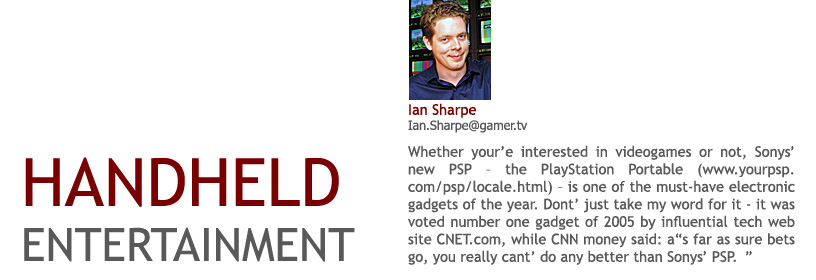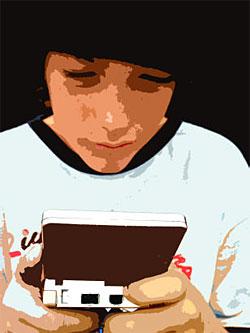Ian Sharpe, Head of Gamer.tv Creative and Business Development, URL: www.gamer.tv


As a games device it’s been universally acclaimed and is certainly the most powerful palm-top around, with graphics that are almost in the same league as PlayStation 2 (BBC News). All the gamers’ favourites are appearing on the console too, including major PlayStation hits like Metal Gear Solid, Gran Turismo and Grand Theft Auto. But what’s really exciting is what else it does – the PSP is a true multimedia gadget and should be a significant gauge of how far the buying public accepts both games and general entertainment merged onto one portable device.
No Phones Here
We’re not talking mobile phone here though – Sony has steered clear of trying to make the PSP talk, as well as sing and dance, but it’s got the rest: wireless communications, information and media storage, plus music and movies on the move. And games - indeed some cases more than games – it’s the movies and music that are exciting people most.
Aiding this is the most remarkable thing about the console: its screen. Sony has gained a reputation for high quality visuals with its VAIO laptop range and flat screen TVs and the PSP’s high definition mini-wide screen offering, covering a remarkable 75 percent of the front surface of the console is certainly striking.
The PSP can play movies officially via its mini-DVD system, called UMD, and unofficially via its MemoryStick Duo expansion. A whole host of recent films have been released on UMD, but while Sony Computer Entertainment (the makers of the PSP) and Sony Pictures Entertainment will be hoping that the format takes off, other commentators have been comparing it to the Betamax saga, where Sony’s system lost out to VHS, and it’s difficult to see how such a small-scale, currently non consumer-writable format can survive when DVD is so well established.
More Memory
This is complicated further by the fact that the PSP’s other built in storage medium, the MemoryStick Duo will soon rival the 3.5Gb UMD in terms of space. Already a 1Gb MemoryStick Duo costs about RO40 and those in the know have been using commercial DVD ripping software to MPEG their own DVDs on a PC, then simply copy them to MemoryStick and watch them on the move. The dubious legality of this method of ‘backing up’ a DVD, if the DVD has been rented or borrowed, has meant that Sony has tried to make it difficult, but as usual third party software stepped in to ease the task.
While Sony may have invented the original Walkman, Apple certainly stole the march on them for the Walkman of the 21 st Century with the iPod ( www.apple.com/ipod ). Apple’s e-jukebox has its detractors but it’s certainly an icon and a must-have gadget. While the PSP has been built-up by Sony as a great music player, for several reasons it just doesn’t compete. Quality isn’t the issue, it’s size: physical and electronic.
Day-in-Day-Out
We’ve seen how the screen is great for movies and games, but it smudges easily and is prone to scratching – and music players are treated far more harshly than video players. Day in, day out use in your pocket as a music player could leave it looking tatty when you want to look at something. Second, a 1Gb MemoryStick is nowhere near the capacity of the basic iPod at 20-60Gb – in fact a 1Gb iPod shuffle doesn’t cost much more than a 1Gb MemoryStick Duo, and the Shuffle plays the music without being plugged into a bulky PSP.
When you look at some of the limitations, you might wonder why the PSP was CNET’s number one gadget of 2005. Unless you’re a gamer there’s probably a better solution for everything the PSP does – a portable DVD player or device like the Archos Pocket Media Assistant ( www.archos.com) for movies and photos, an iPod for music and a decent PDA for everything else.
The ‘S’ Factor
But that disregards the ‘S’ factor. The PSP, plain and simple, is a sexy gadget. Its sleek black shape, large, attractive screen and multi-purpose abilities means that while it’s a jack of all trades, and master of one – gaming – it attracts attention and basically begs to be bought.
Issues at Play
Beyond all the initial buzz though it’s clear that Sony needs to address a couple of issues if they want to make it a true consumer device and not just a multipurpose toy for cash rich gamers who want the equivalent of an electronic Swiss Army Knife in their bag.
First of all they need to start thinking beyond the usual gamut of games – platformers, shooters and driving titles, to products that genuinely innovate.
Nintendo’s ( www.nintendo.com ) recently launched DS, or dual screen, might not be as sexy, but its touchscreen interface and microphone allow new methods of interaction and control which the PSP doesn’t have – and these new controls have allowed Nintendo to innovate with gameplay.
Nintendo’s latest DS product, Nintendogs ( www.nintendogs.com) is like a Tamagotchi ( www.tamagotchi.com) with a giant selection of realistic looking and acting pups that flourish and grow as you stroke them like a real pet, and play with them using the touch screen. It won’t appeal to hard core gamers but imagine the vast markets it could open up beyond traditional games buyers?
Sony and its third party developers did this to a certain extent with music, karaoke and dance titles on the PS2 – and the sooner it does it with PSP the better. At least the provision of a USB port allows for expansions – and the sooner Sony innovates there the better.
Secondly, Sony should give the system and its users more freedom – make UMD writers cheaply available for people to run with their home PC and relax the standards and encoding required to play movies. Having decided to support UMD, the movie industry should also make commercial UMD movies cheaper – let’s face it, why does anyone want to pay more for a UMD than they have to for the same DVD, which can be ripped anyway?
Lastly, some form of video output needs to be made available. It’s all very well playing games and watching movies on the move, but there comes a time when you might want to plug it into a television and watch your UMD movie or play your game on a bigger screen. This is a feature of most portable DVD devices, so why not make it a feature of the PSP?
Perhaps a Re-think?
The PSP is, without doubt, a landmark device with a lot of potential – alongside the next generation of home consoles – to bring games to the attention of a wider audience. But Sony – which is currently struggling with losses as a global corporation - needs to think beyond just the obvious applications and marketing strategies if this hand held prodigy is to alter its fortunes as significantly as the iPod did for Apple.








